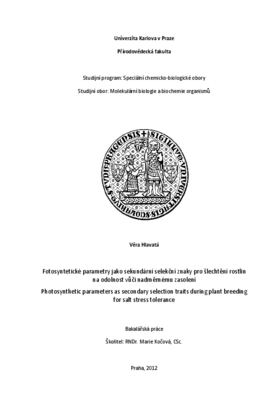Fotosyntetické parametry jako sekundární selekční znaky pro šlechtění rostlin na odolnost vůči nadměrnému zasolení
Photosynthetic parameters as secondary selection traits during plant breeding for salt stress tolerance
bachelor thesis (DEFENDED)

View/
Permanent link
http://hdl.handle.net/20.500.11956/42953Identifiers
Study Information System: 90847
CU Caralogue: 990015245190106986
Collections
- Kvalifikační práce [20734]
Author
Advisor
Referee
Lhotáková, Zuzana
Faculty / Institute
Faculty of Science
Discipline
Molecular Biology and Biochemistry of Organisms
Department
Department of Genetics and Microbiology
Date of defense
14. 9. 2012
Publisher
Univerzita Karlova, Přírodovědecká fakultaLanguage
Czech
Grade
Good
Keywords (Czech)
stres, salinita, tolerance, fotosyntéza, obsah chlorofylu, fluorescence, selekční znakyKeywords (English)
stress, salinity, tolerance, photosynthesis, chlorophyll content, fluorescence, selection markersVysoká koncentrace solí v půdě patří mezi abiotické stresové faktory, které významnou měrou negativně ovlivňují růst a vývoj rostlin a v konečném důsledku jejich výnos. Zvýšená tolerance rostlin vůči tomuto stresoru je proto jedním z hlavních cílů šlechtitelských programů zejména v oblastech, kde je salinita nejvýznamnějším stresorem. Pro testování tolerance k zasolení je doporučována celá řada fyziologických znaků. Parametry spojené s fotosyntézou hrají nepochybně hlavní roli, protože fotosyntetický aparát reaguje na stresové podmínky velmi rychle. Obecně jsou pro testování tolerance vůči abiotickým stresorům z fotosyntetických parametrů doporučovány rychlost čisté fotosyntézy, obsah chlorofylu, fluorescence chlorofylu a některé další parametry. Všechny tyto parametry jsou využívány i pro testování reakce různých hospodářsky významných rostlin na stres nadměrným zasolením. Výhodou měření těchto charakteristik je rychlost, obvykle neinvazivní techniky měření a zejména možnost současného porovnání většího souboru genotypů. Přesto, že byly některé znaky doporučeny jako vhodné pro testování tolerance vůči stresu, výsledky nejsou jednoznačné. Cílem předložené práce bylo podat stručný přehled výsledků prací, zabývajících se studiem změn vybraných fotosyntetických parametrů v souvislosti se stresem v důsledku...
High salt concentration is important abiotic stress factor that negatively affect plant growth and development and finally also their yield. Increase of plant tolerance to this stress factor is thus one of the most important goals in breeding programmes, particularly in areas with saline environment. Various physiological traits have been suggested for the testing of plant tolerance to improved salinity. Photosynthetic parameters play undoubtedly the main role, because of their rapid response to stress conditions. Generally, photosynthetic rate, chlorophyll content and chlorophyll fluorescence belong to the photosynthetic parameters, that are usually recommended for the evaluation of stress tolerance. All of them were also used for study of salt tolerance in crop plants. The advantages of these measurements are rapidity, non-invasive techniques and particularly, the possibility to test wide collection of genotypes during the short period. Although some of the parameters were recommended for the evaluation of stress tolerance, the results are still ambiguous. The aim of this study was to briefly describe the changes of selected photosynthetic parameters of different plant species in consequence of salt stress and assess the usefulness of these parameters for reliable screening for salt tolerance.
